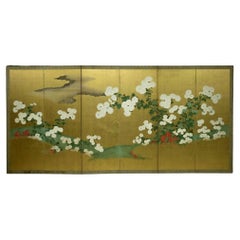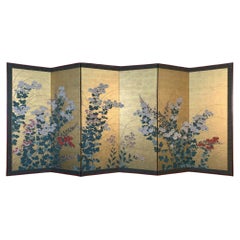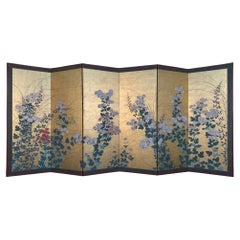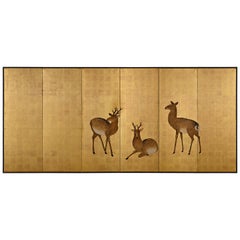Rimpa School Furniture
to
2
2
1
1
Late Edo Period Rinpa School Chrysanthemum Blossom Screen
By Rimpa School
Located in Fukuoka, JP
Late Edo Period Rinpa School Chrysanthemum Blossom Screen
Period: late Edo, early 19th century
Size: 364 x 172 cm (143 x 67 inches)
SKU: PTA13
This exquisite late Edo period Rinpa ...
Category
18th Century Japanese Edo Antique Rimpa School Furniture
Materials
Paper
Early 19th Century Rimpa School Floral Screen
By Rimpa School
Located in Fukuoka, JP
Early 19th Century Rimpa School Floral Screen
Period: Early 19th Century
Dimensions: 367x171 cm (144.5x67.3 inches)
SKU: RJ118
This 6-panel gold-leafed screen is a splendid represe...
Category
Early 19th Century Japanese Edo Antique Rimpa School Furniture
Materials
Gold Leaf
Early 19th Century Rimpa School Floral Screen
By Rimpa School
Located in Fukuoka, JP
Early 19th Century Rimpa School Floral Screen
Period: Early 19th Century
Dimensions: 367x171 cm (144.5x67.3 inches)
SKU: RJ118/2
This 6-panel gold-leafed screen is a splendid repre...
Category
Early 19th Century Japanese Edo Antique Rimpa School Furniture
Materials
Gold Leaf
Related Items
19th Century Japanese Screen, Deer in Spring, Maruyama Shijo School
Located in Kyoto, JP
A six-panel Japanese folding screen from the leading Maruyama-Shijo artist Okamoto Toyohiko (1773-1845). Simply featuring three deer and a few sprigs of foliage on a sumptuous gold-leaf background this work emphasizes naturalistic expression and a masterful use of negative space. Reduced to its most basic elements, the blank spaces inspire imagination and evoke the smells, sounds and even the weather of the scene. Whilst deer are traditionally depicted in association with autumn, here the green growth on the tops of the foliage indicates the season of spring. The work references Maruyama Okyo’s two-panel deer screen...
Category
Early 19th Century Japanese Edo Antique Rimpa School Furniture
Materials
Gold Leaf
$28,000
H 67 in W 148 in D 0.75 in
19th Century Japanese Edo Six Panel Kano School Landscape Screen
Located in Rio Vista, CA
Late Edo period 19th century Japanese six-panel landscape screen featuring a cypress tree over a flowering hibiscus with a pair of hototogisu birds. Kano school painted with ink and ...
Category
19th Century Japanese Edo Antique Rimpa School Furniture
Materials
Silk, Wood, Paper
18th Century Japanese Kano School Landscape Screen
Located in Prahran, Victoria
Japanese Kano school screen with pine tree, camellias, cherry blossom and Chinese figures in the landscape, circa 18th century.
Materials: Pigmen...
Category
18th Century Japanese Antique Rimpa School Furniture
Materials
Silver Leaf
19th Century Japanese Edo Screen Kano School Garden Terrace
Located in Rio Vista, CA
Fantastic 19th century Japanese Edo/Tokugawa period two-panel byobu screen featuring Chinese children frolicking on a garden terrace with a pavilion and large pine tree. Made in the ...
Category
19th Century Japanese Edo Antique Rimpa School Furniture
Materials
Brass, Gold Leaf
Kiku to Hagi Byobu, Rinpa School Style, Edo Period.
Located in Point Richmond, CA
A Chrysanthemum and Bush Clover painting on gold leaf six-panel folding screen, painted with clusters of leafy green chrysanthemum plants with white blossoms having moriage relief petals of gofun growing amidst pink blossoming bush clover within a bunched bush clover garden fence rendered in lighter gold relief, all on a background entirely of rich gold leaf. These two flowers are symbolic of Japan and the autumn season. The classic patterned paper verso with a Naga Antiques...
Category
Early 1800s Japanese Edo Antique Rimpa School Furniture
Materials
Gold Leaf
19th Century Japanese Shunga Hand-Scroll, Katsukawa School
Located in Kyoto, JP
Shunga
Unknown artist
Meiji era, circa 1880
Hand-scroll mounted with 12 paintings
Ink, pigment and gofun on silk
Dimensions:
Each image measures H. 23.2 cm x W. 34.4 cm (9.15” x 13.5”)
The hand-scroll measures H. 28 cm x W. 540 cm (11” x 212”)
A set of 12 late 19th century Japanese Shunga paintings mounted as a hand-scroll. Two of the leaves bear the signature and seal ‘Setsuzan’, although we are unable to confirm the identity of the artist using this art name. 6 of the 12 images are taken almost directly from Katsukawa Shuncho’s late 18th century woodblock series, ‘Erotic Pictures...
Category
Late 19th Century Japanese Meiji Antique Rimpa School Furniture
Materials
Silk
19th Century Chinese Window Lattice Panel Screen
Located in New York, NY
19th Century Window Lattice Screen. Very special Lattice Screen Window Panel from Shanxi China 19th century. Wonderfully assembled sculpted pieces of Cypress wood with each face ro...
Category
Mid-19th Century Chinese Qing Antique Rimpa School Furniture
Materials
Cypress
Japanese Edo Four Panel Screen Flowering White Chrysanthemums
Located in Rio Vista, CA
19th century extraordinary Japanese late Edo/early Meiji period four-panel byobu screen featuring flowering white chrysanthemums painted in a moriage (raised pigment) style. The pain...
Category
19th Century Japanese Edo Antique Rimpa School Furniture
Materials
Brass, Gold Leaf
“Kiku Byobu”, a six-panel chrysanthemum folding screen, Rinpa School
Located in Point Richmond, CA
“Kiku Byobu”, a six-panel chrysanthemum folding screen, Rinpa School, Meiji Period (1869-1912).
Painted with several variations of white moriage chrysanthemums interspersed with sma...
Category
Late 19th Century Japanese Meiji Antique Rimpa School Furniture
Materials
Paper
19th Century Chinese Gilt Inkwash Painted Screen
Located in Lomita, CA
This is a singular piece, a framed vintage Chinese gilt and inkwash miniature six-fold paper screen, that was possibly a salesman's sample, and it is beautiful.
This is from the la...
Category
Late 19th Century Chinese Chinese Export Antique Rimpa School Furniture
Materials
Giltwood
Japanese Edo Screen Kano School Isle of Immortals
Located in Rio Vista, CA
Fascinating 19th century Japanese Edo period six-panel byobu screen depicting the Isle of Immortals. The painting features white Manchurian cranes among pines and flowering plum cent...
Category
19th Century Japanese Edo Antique Rimpa School Furniture
Materials
Brass, Gold Leaf
Japanese Edo Four Panel Screen Kano School Filial Piety
Located in Rio Vista, CA
Early 19th century late Edo period Japanese four-panel screen depicting examples from the 24 paragons of filial piety. Painted in the Kano School style featuring figures in colorful,...
Category
19th Century Japanese Edo Antique Rimpa School Furniture
Materials
Brass, Gold Leaf
Previously Available Items
Edo Period 19th Century Japanese Folding Screen Six Panels Flowers on Gold Leaf
By Rimpa School
Located in Brescia, IT
Clouds of gold, water and many colorful flowers: Japanese six-panel folding screen by Rimpa School. Hand painted with rice mineral pigments and inks on rice paper and gold leaf.
Category
Early 19th Century Japanese Edo Antique Rimpa School Furniture
Materials
Gold Leaf
H 42.92 in W 113 in D 0.79 in
Rimpa School furniture for sale on 1stDibs.
Rimpa School furniture are available for sale on 1stDibs. If you’re looking for additional options, many customers also consider furniture by Utagawa Hiroshige (Ando Hiroshige), and Arita.





